HI6008 - Promoting Workplace Diversity in the Travel Business Sector
VerifiedAdded on 2023/06/13
|19
|4179
|74
Report
AI Summary
This research proposal explores the promotion of workplace diversity within the travel business sector. It identifies the benefits and opportunities that diversity brings, such as fostering business innovation and knowledge transfer, while also addressing challenges like communication barriers and potential discrimination. The proposal outlines strategies to promote diversity, including creating diverse task forces, implementing effective diversity policies, and providing diversity training. It includes primary and secondary research questions to guide the investigation, along with a detailed research design and methodology encompassing both qualitative and quantitative approaches. The proposal also acknowledges research limitations and presents a time schedule for project completion, aiming to provide insights into how travel businesses can effectively manage and leverage workplace diversity for enhanced business outcomes. This document is available on Desklib, a platform providing a wealth of study resources for students.
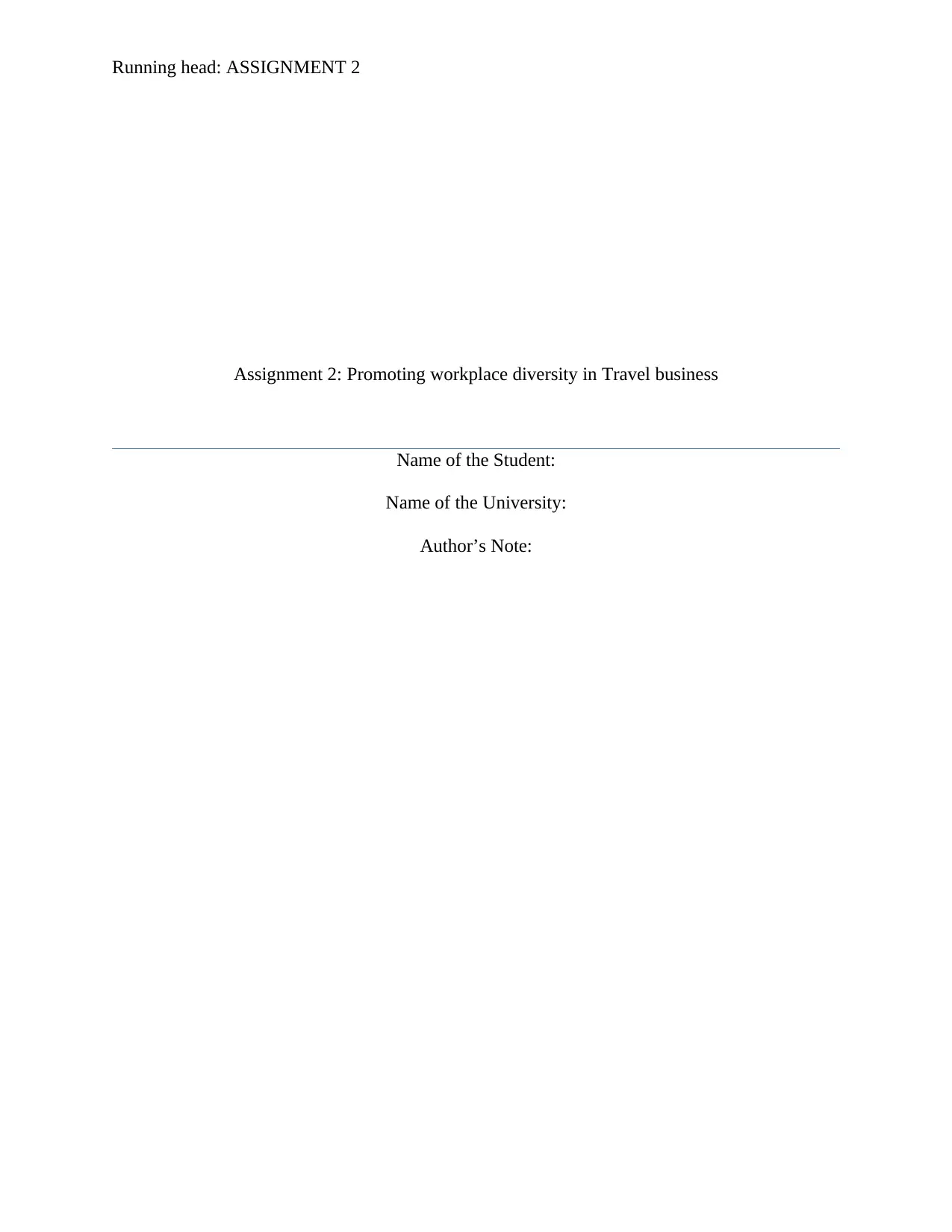
Running head: ASSIGNMENT 2
Assignment 2: Promoting workplace diversity in Travel business
Name of the Student:
Name of the University:
Author’s Note:
Assignment 2: Promoting workplace diversity in Travel business
Name of the Student:
Name of the University:
Author’s Note:
Paraphrase This Document
Need a fresh take? Get an instant paraphrase of this document with our AI Paraphraser

1ASSIGNMENT 2
Table of Contents
1. Introduction..................................................................................................................................3
2. Project Objective.........................................................................................................................4
3. Project Scope...............................................................................................................................4
4. Literature review..........................................................................................................................4
4.1 Importance of Workplace Diversity in Travel Business........................................................4
4.2 Issues of Workplace Diversity in Travel Business................................................................6
4.3 Strategies to Promote Workplace Diversity in Travel Business............................................7
5. Research Questions......................................................................................................................8
5.1 Primary Question...................................................................................................................8
5.2 Secondary Questions.............................................................................................................8
6. Research Design and Methodology.............................................................................................9
6.1 Qualitative Research..............................................................................................................9
6.1.1 Process of Qualitative Research.....................................................................................9
6.1.2 Approaches to Reliability and Validity..........................................................................9
6.1.3 Sampling.......................................................................................................................10
6.1.4 Sample Size..................................................................................................................10
6.1.5 Data Collection Method................................................................................................10
6.1.6 Variable Specification..................................................................................................11
6.2 Quantitative Research..........................................................................................................11
Table of Contents
1. Introduction..................................................................................................................................3
2. Project Objective.........................................................................................................................4
3. Project Scope...............................................................................................................................4
4. Literature review..........................................................................................................................4
4.1 Importance of Workplace Diversity in Travel Business........................................................4
4.2 Issues of Workplace Diversity in Travel Business................................................................6
4.3 Strategies to Promote Workplace Diversity in Travel Business............................................7
5. Research Questions......................................................................................................................8
5.1 Primary Question...................................................................................................................8
5.2 Secondary Questions.............................................................................................................8
6. Research Design and Methodology.............................................................................................9
6.1 Qualitative Research..............................................................................................................9
6.1.1 Process of Qualitative Research.....................................................................................9
6.1.2 Approaches to Reliability and Validity..........................................................................9
6.1.3 Sampling.......................................................................................................................10
6.1.4 Sample Size..................................................................................................................10
6.1.5 Data Collection Method................................................................................................10
6.1.6 Variable Specification..................................................................................................11
6.2 Quantitative Research..........................................................................................................11
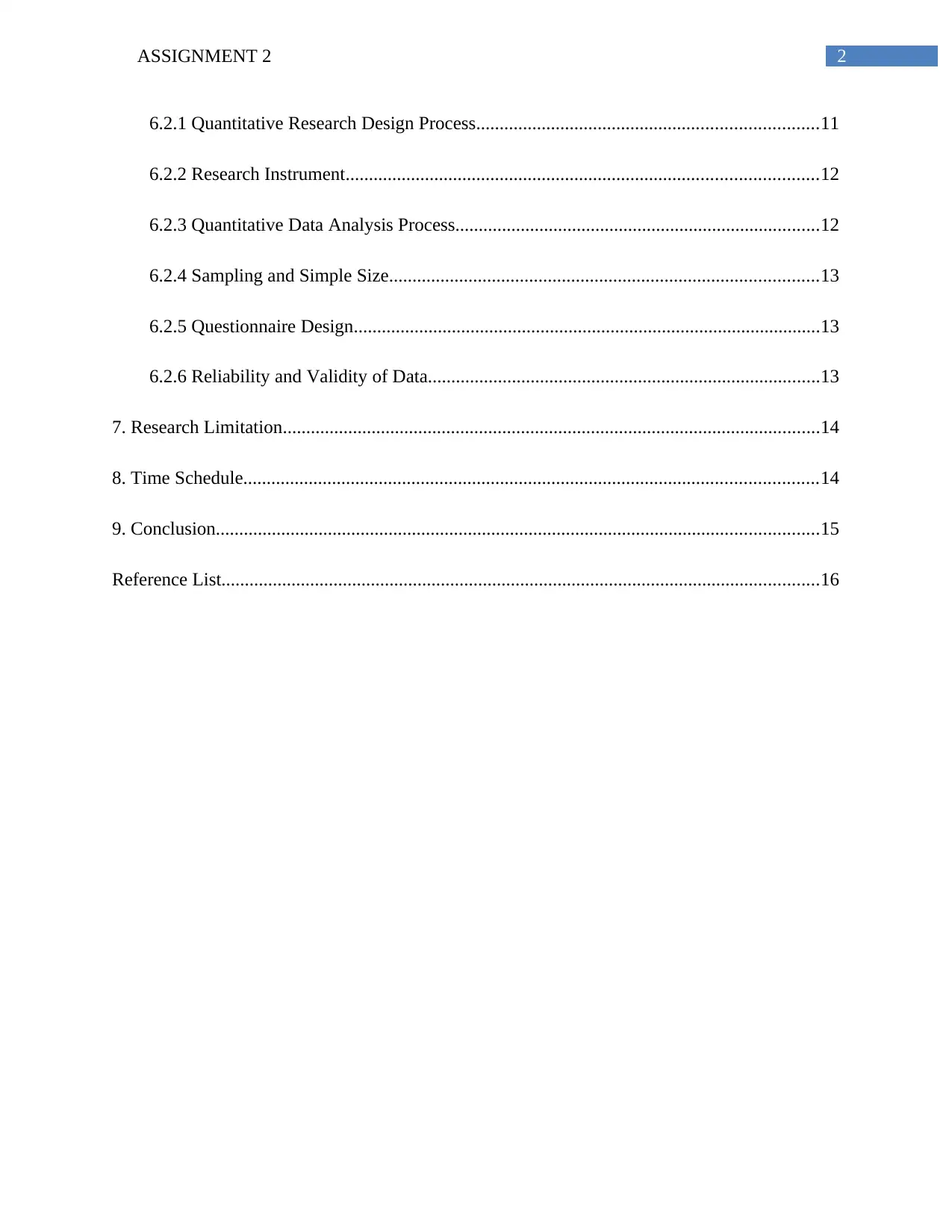
2ASSIGNMENT 2
6.2.1 Quantitative Research Design Process.........................................................................11
6.2.2 Research Instrument.....................................................................................................12
6.2.3 Quantitative Data Analysis Process..............................................................................12
6.2.4 Sampling and Simple Size............................................................................................13
6.2.5 Questionnaire Design....................................................................................................13
6.2.6 Reliability and Validity of Data....................................................................................13
7. Research Limitation...................................................................................................................14
8. Time Schedule...........................................................................................................................14
9. Conclusion.................................................................................................................................15
Reference List................................................................................................................................16
6.2.1 Quantitative Research Design Process.........................................................................11
6.2.2 Research Instrument.....................................................................................................12
6.2.3 Quantitative Data Analysis Process..............................................................................12
6.2.4 Sampling and Simple Size............................................................................................13
6.2.5 Questionnaire Design....................................................................................................13
6.2.6 Reliability and Validity of Data....................................................................................13
7. Research Limitation...................................................................................................................14
8. Time Schedule...........................................................................................................................14
9. Conclusion.................................................................................................................................15
Reference List................................................................................................................................16
⊘ This is a preview!⊘
Do you want full access?
Subscribe today to unlock all pages.

Trusted by 1+ million students worldwide
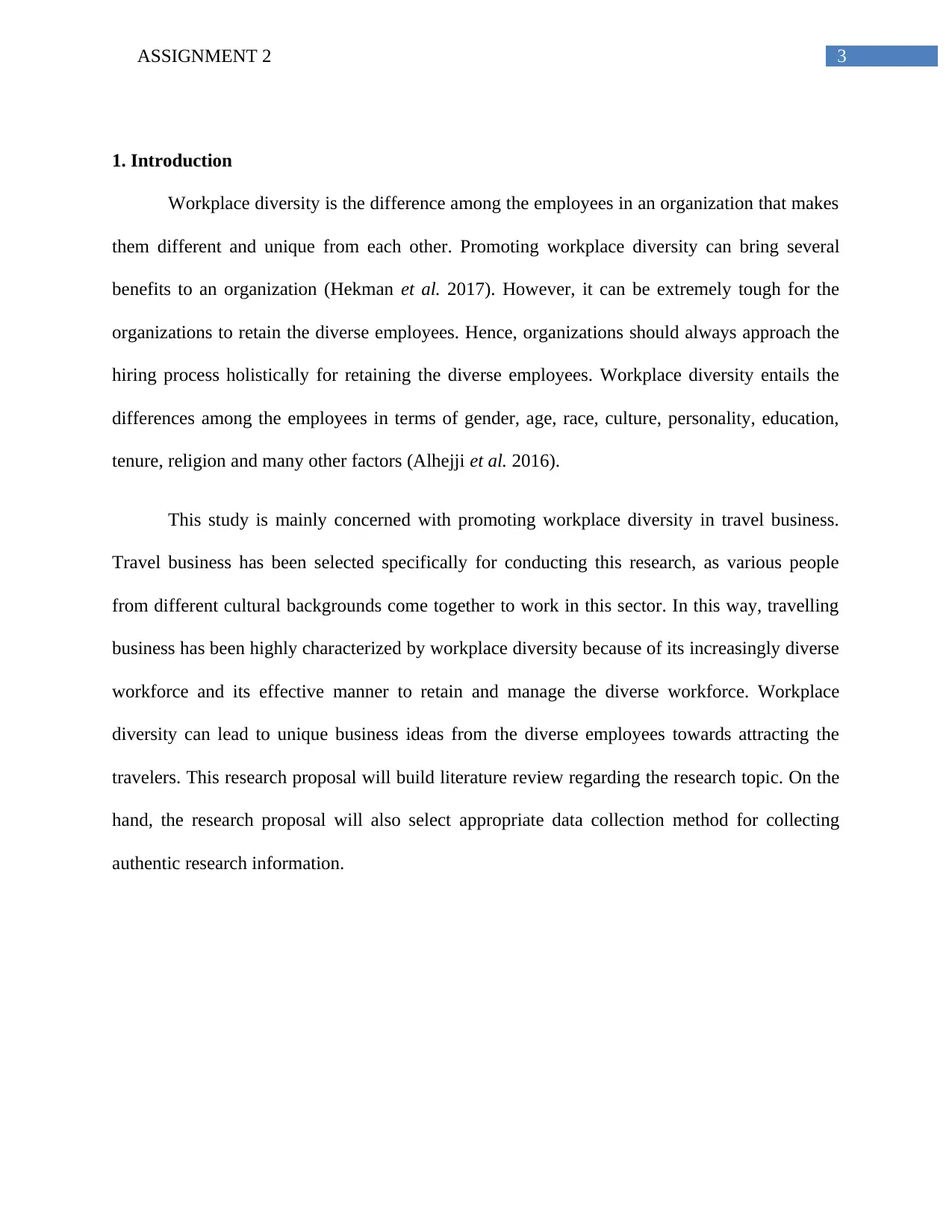
3ASSIGNMENT 2
1. Introduction
Workplace diversity is the difference among the employees in an organization that makes
them different and unique from each other. Promoting workplace diversity can bring several
benefits to an organization (Hekman et al. 2017). However, it can be extremely tough for the
organizations to retain the diverse employees. Hence, organizations should always approach the
hiring process holistically for retaining the diverse employees. Workplace diversity entails the
differences among the employees in terms of gender, age, race, culture, personality, education,
tenure, religion and many other factors (Alhejji et al. 2016).
This study is mainly concerned with promoting workplace diversity in travel business.
Travel business has been selected specifically for conducting this research, as various people
from different cultural backgrounds come together to work in this sector. In this way, travelling
business has been highly characterized by workplace diversity because of its increasingly diverse
workforce and its effective manner to retain and manage the diverse workforce. Workplace
diversity can lead to unique business ideas from the diverse employees towards attracting the
travelers. This research proposal will build literature review regarding the research topic. On the
hand, the research proposal will also select appropriate data collection method for collecting
authentic research information.
1. Introduction
Workplace diversity is the difference among the employees in an organization that makes
them different and unique from each other. Promoting workplace diversity can bring several
benefits to an organization (Hekman et al. 2017). However, it can be extremely tough for the
organizations to retain the diverse employees. Hence, organizations should always approach the
hiring process holistically for retaining the diverse employees. Workplace diversity entails the
differences among the employees in terms of gender, age, race, culture, personality, education,
tenure, religion and many other factors (Alhejji et al. 2016).
This study is mainly concerned with promoting workplace diversity in travel business.
Travel business has been selected specifically for conducting this research, as various people
from different cultural backgrounds come together to work in this sector. In this way, travelling
business has been highly characterized by workplace diversity because of its increasingly diverse
workforce and its effective manner to retain and manage the diverse workforce. Workplace
diversity can lead to unique business ideas from the diverse employees towards attracting the
travelers. This research proposal will build literature review regarding the research topic. On the
hand, the research proposal will also select appropriate data collection method for collecting
authentic research information.
Paraphrase This Document
Need a fresh take? Get an instant paraphrase of this document with our AI Paraphraser
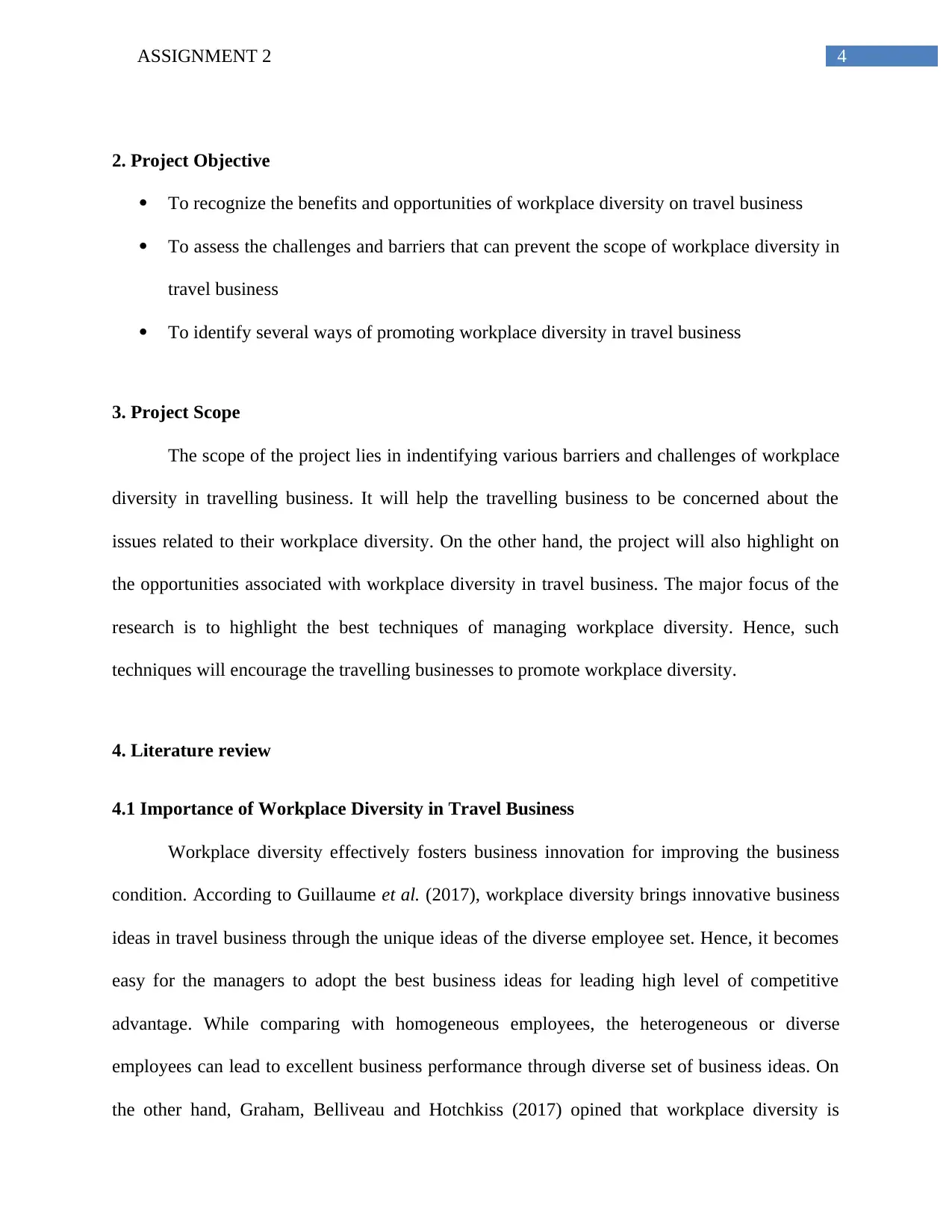
4ASSIGNMENT 2
2. Project Objective
To recognize the benefits and opportunities of workplace diversity on travel business
To assess the challenges and barriers that can prevent the scope of workplace diversity in
travel business
To identify several ways of promoting workplace diversity in travel business
3. Project Scope
The scope of the project lies in indentifying various barriers and challenges of workplace
diversity in travelling business. It will help the travelling business to be concerned about the
issues related to their workplace diversity. On the other hand, the project will also highlight on
the opportunities associated with workplace diversity in travel business. The major focus of the
research is to highlight the best techniques of managing workplace diversity. Hence, such
techniques will encourage the travelling businesses to promote workplace diversity.
4. Literature review
4.1 Importance of Workplace Diversity in Travel Business
Workplace diversity effectively fosters business innovation for improving the business
condition. According to Guillaume et al. (2017), workplace diversity brings innovative business
ideas in travel business through the unique ideas of the diverse employee set. Hence, it becomes
easy for the managers to adopt the best business ideas for leading high level of competitive
advantage. While comparing with homogeneous employees, the heterogeneous or diverse
employees can lead to excellent business performance through diverse set of business ideas. On
the other hand, Graham, Belliveau and Hotchkiss (2017) opined that workplace diversity is
2. Project Objective
To recognize the benefits and opportunities of workplace diversity on travel business
To assess the challenges and barriers that can prevent the scope of workplace diversity in
travel business
To identify several ways of promoting workplace diversity in travel business
3. Project Scope
The scope of the project lies in indentifying various barriers and challenges of workplace
diversity in travelling business. It will help the travelling business to be concerned about the
issues related to their workplace diversity. On the other hand, the project will also highlight on
the opportunities associated with workplace diversity in travel business. The major focus of the
research is to highlight the best techniques of managing workplace diversity. Hence, such
techniques will encourage the travelling businesses to promote workplace diversity.
4. Literature review
4.1 Importance of Workplace Diversity in Travel Business
Workplace diversity effectively fosters business innovation for improving the business
condition. According to Guillaume et al. (2017), workplace diversity brings innovative business
ideas in travel business through the unique ideas of the diverse employee set. Hence, it becomes
easy for the managers to adopt the best business ideas for leading high level of competitive
advantage. While comparing with homogeneous employees, the heterogeneous or diverse
employees can lead to excellent business performance through diverse set of business ideas. On
the other hand, Graham, Belliveau and Hotchkiss (2017) opined that workplace diversity is

5ASSIGNMENT 2
extremely helpful for knowledge transfer among the employees. Diverse employees are having
different types of knowledge regarding the business aspects. In such situation, the diverse
employees can effective share their knowledge with each other towards broadening their overall
knowledge. In this way, the organizations can better manage their knowledge base towards
leading successful travel business (Bond and Haynes 2014). Moreover, the employees from
different backgrounds can bring varieties of solutions towards achieving common organizational
goals.
Employee from diverse culture, languages, religions and race can understand the unique
customer needs having different backgrounds. Furthermore, Sabharwal (2014) opined that hiring
employees, who can converse different languages can help the travel businesses in dealing with
global customers leading to successful global business. Hence, such diverse employees can
provide customized solutions to different kinds of customers leading to high level of competitive
advantage. On the other hand, Peretz, Levi and Fried (2015) opined that workplace diversity
builds positive reputation for travel businesses in the job market. Moreover, diversity creates a
perception among the potential job candidates the organizations treat their employees fairly
regardless of their backgrounds. Hence, the organizations having workplace diversity can better
attract top talents from the job market. Giving equal values to the diverse employees give a feel
of fair treatment for them (Davis, Frolova and Callahan 2016). In this way, workplace diversity
can even lead to high morale of the diverse employees in travel businesses. Moreover, feeling
valued actually improves the morale of the employees and promote positive culture in the
workplaces of travel businesses.
extremely helpful for knowledge transfer among the employees. Diverse employees are having
different types of knowledge regarding the business aspects. In such situation, the diverse
employees can effective share their knowledge with each other towards broadening their overall
knowledge. In this way, the organizations can better manage their knowledge base towards
leading successful travel business (Bond and Haynes 2014). Moreover, the employees from
different backgrounds can bring varieties of solutions towards achieving common organizational
goals.
Employee from diverse culture, languages, religions and race can understand the unique
customer needs having different backgrounds. Furthermore, Sabharwal (2014) opined that hiring
employees, who can converse different languages can help the travel businesses in dealing with
global customers leading to successful global business. Hence, such diverse employees can
provide customized solutions to different kinds of customers leading to high level of competitive
advantage. On the other hand, Peretz, Levi and Fried (2015) opined that workplace diversity
builds positive reputation for travel businesses in the job market. Moreover, diversity creates a
perception among the potential job candidates the organizations treat their employees fairly
regardless of their backgrounds. Hence, the organizations having workplace diversity can better
attract top talents from the job market. Giving equal values to the diverse employees give a feel
of fair treatment for them (Davis, Frolova and Callahan 2016). In this way, workplace diversity
can even lead to high morale of the diverse employees in travel businesses. Moreover, feeling
valued actually improves the morale of the employees and promote positive culture in the
workplaces of travel businesses.
⊘ This is a preview!⊘
Do you want full access?
Subscribe today to unlock all pages.

Trusted by 1+ million students worldwide
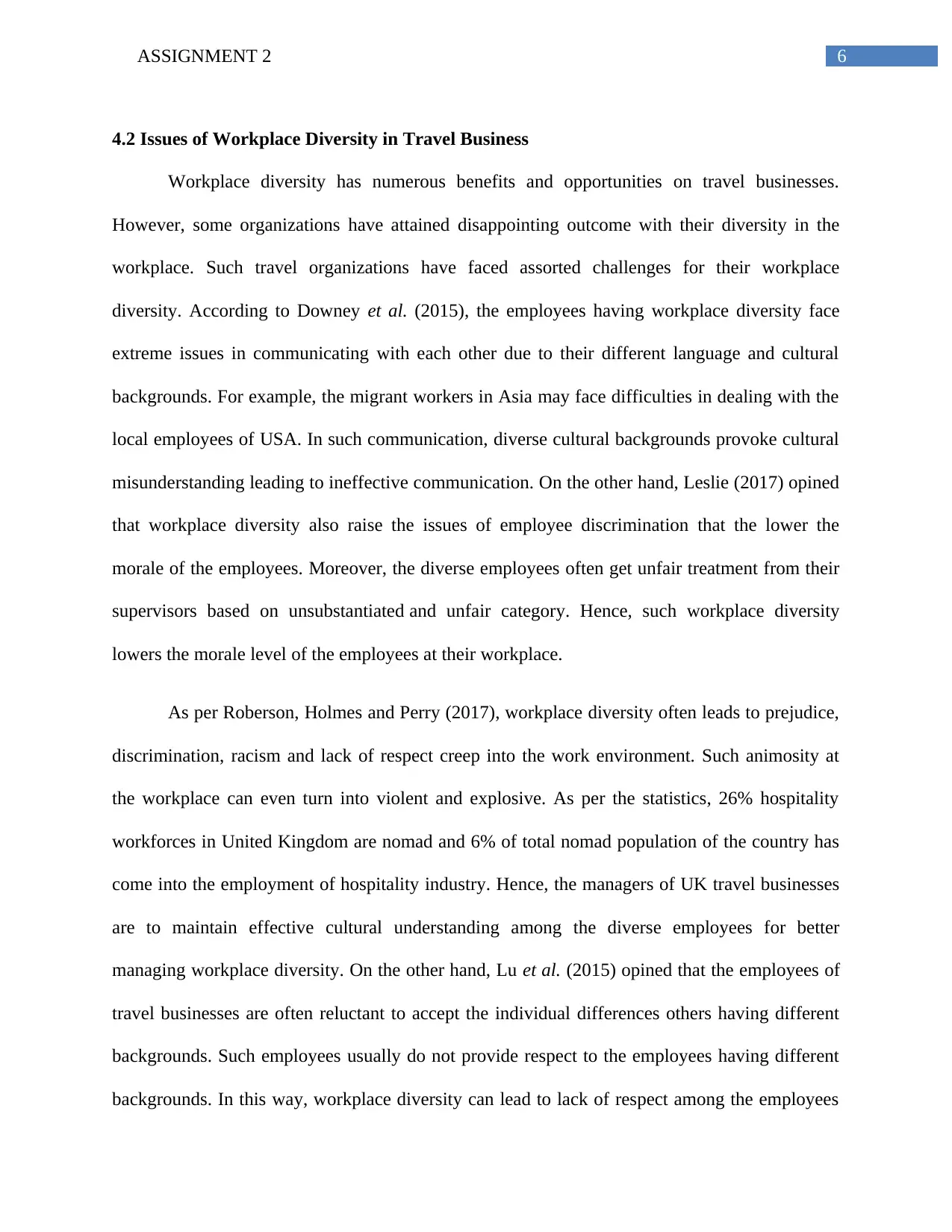
6ASSIGNMENT 2
4.2 Issues of Workplace Diversity in Travel Business
Workplace diversity has numerous benefits and opportunities on travel businesses.
However, some organizations have attained disappointing outcome with their diversity in the
workplace. Such travel organizations have faced assorted challenges for their workplace
diversity. According to Downey et al. (2015), the employees having workplace diversity face
extreme issues in communicating with each other due to their different language and cultural
backgrounds. For example, the migrant workers in Asia may face difficulties in dealing with the
local employees of USA. In such communication, diverse cultural backgrounds provoke cultural
misunderstanding leading to ineffective communication. On the other hand, Leslie (2017) opined
that workplace diversity also raise the issues of employee discrimination that the lower the
morale of the employees. Moreover, the diverse employees often get unfair treatment from their
supervisors based on unsubstantiated and unfair category. Hence, such workplace diversity
lowers the morale level of the employees at their workplace.
As per Roberson, Holmes and Perry (2017), workplace diversity often leads to prejudice,
discrimination, racism and lack of respect creep into the work environment. Such animosity at
the workplace can even turn into violent and explosive. As per the statistics, 26% hospitality
workforces in United Kingdom are nomad and 6% of total nomad population of the country has
come into the employment of hospitality industry. Hence, the managers of UK travel businesses
are to maintain effective cultural understanding among the diverse employees for better
managing workplace diversity. On the other hand, Lu et al. (2015) opined that the employees of
travel businesses are often reluctant to accept the individual differences others having different
backgrounds. Such employees usually do not provide respect to the employees having different
backgrounds. In this way, workplace diversity can lead to lack of respect among the employees
4.2 Issues of Workplace Diversity in Travel Business
Workplace diversity has numerous benefits and opportunities on travel businesses.
However, some organizations have attained disappointing outcome with their diversity in the
workplace. Such travel organizations have faced assorted challenges for their workplace
diversity. According to Downey et al. (2015), the employees having workplace diversity face
extreme issues in communicating with each other due to their different language and cultural
backgrounds. For example, the migrant workers in Asia may face difficulties in dealing with the
local employees of USA. In such communication, diverse cultural backgrounds provoke cultural
misunderstanding leading to ineffective communication. On the other hand, Leslie (2017) opined
that workplace diversity also raise the issues of employee discrimination that the lower the
morale of the employees. Moreover, the diverse employees often get unfair treatment from their
supervisors based on unsubstantiated and unfair category. Hence, such workplace diversity
lowers the morale level of the employees at their workplace.
As per Roberson, Holmes and Perry (2017), workplace diversity often leads to prejudice,
discrimination, racism and lack of respect creep into the work environment. Such animosity at
the workplace can even turn into violent and explosive. As per the statistics, 26% hospitality
workforces in United Kingdom are nomad and 6% of total nomad population of the country has
come into the employment of hospitality industry. Hence, the managers of UK travel businesses
are to maintain effective cultural understanding among the diverse employees for better
managing workplace diversity. On the other hand, Lu et al. (2015) opined that the employees of
travel businesses are often reluctant to accept the individual differences others having different
backgrounds. Such employees usually do not provide respect to the employees having different
backgrounds. In this way, workplace diversity can lead to lack of respect among the employees
Paraphrase This Document
Need a fresh take? Get an instant paraphrase of this document with our AI Paraphraser
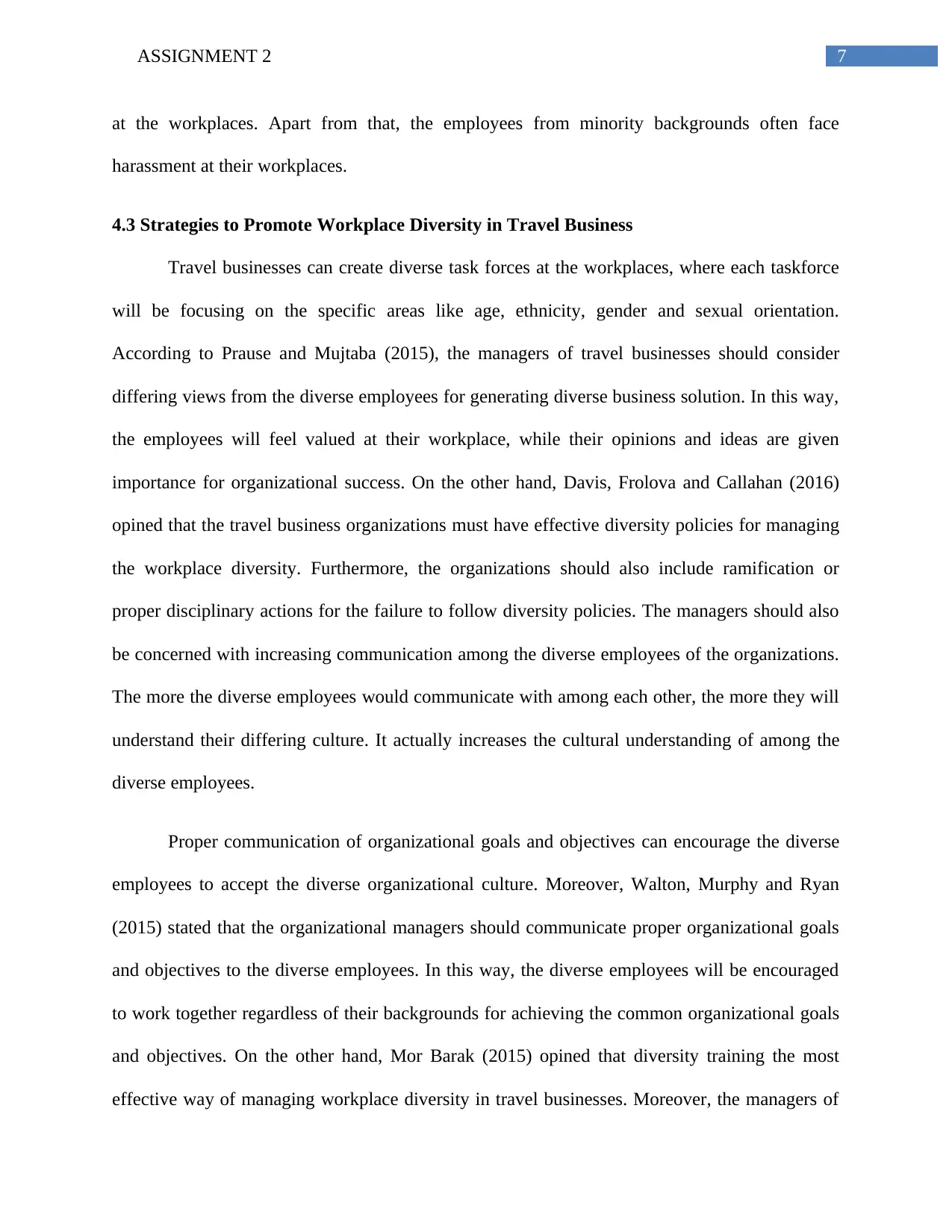
7ASSIGNMENT 2
at the workplaces. Apart from that, the employees from minority backgrounds often face
harassment at their workplaces.
4.3 Strategies to Promote Workplace Diversity in Travel Business
Travel businesses can create diverse task forces at the workplaces, where each taskforce
will be focusing on the specific areas like age, ethnicity, gender and sexual orientation.
According to Prause and Mujtaba (2015), the managers of travel businesses should consider
differing views from the diverse employees for generating diverse business solution. In this way,
the employees will feel valued at their workplace, while their opinions and ideas are given
importance for organizational success. On the other hand, Davis, Frolova and Callahan (2016)
opined that the travel business organizations must have effective diversity policies for managing
the workplace diversity. Furthermore, the organizations should also include ramification or
proper disciplinary actions for the failure to follow diversity policies. The managers should also
be concerned with increasing communication among the diverse employees of the organizations.
The more the diverse employees would communicate with among each other, the more they will
understand their differing culture. It actually increases the cultural understanding of among the
diverse employees.
Proper communication of organizational goals and objectives can encourage the diverse
employees to accept the diverse organizational culture. Moreover, Walton, Murphy and Ryan
(2015) stated that the organizational managers should communicate proper organizational goals
and objectives to the diverse employees. In this way, the diverse employees will be encouraged
to work together regardless of their backgrounds for achieving the common organizational goals
and objectives. On the other hand, Mor Barak (2015) opined that diversity training the most
effective way of managing workplace diversity in travel businesses. Moreover, the managers of
at the workplaces. Apart from that, the employees from minority backgrounds often face
harassment at their workplaces.
4.3 Strategies to Promote Workplace Diversity in Travel Business
Travel businesses can create diverse task forces at the workplaces, where each taskforce
will be focusing on the specific areas like age, ethnicity, gender and sexual orientation.
According to Prause and Mujtaba (2015), the managers of travel businesses should consider
differing views from the diverse employees for generating diverse business solution. In this way,
the employees will feel valued at their workplace, while their opinions and ideas are given
importance for organizational success. On the other hand, Davis, Frolova and Callahan (2016)
opined that the travel business organizations must have effective diversity policies for managing
the workplace diversity. Furthermore, the organizations should also include ramification or
proper disciplinary actions for the failure to follow diversity policies. The managers should also
be concerned with increasing communication among the diverse employees of the organizations.
The more the diverse employees would communicate with among each other, the more they will
understand their differing culture. It actually increases the cultural understanding of among the
diverse employees.
Proper communication of organizational goals and objectives can encourage the diverse
employees to accept the diverse organizational culture. Moreover, Walton, Murphy and Ryan
(2015) stated that the organizational managers should communicate proper organizational goals
and objectives to the diverse employees. In this way, the diverse employees will be encouraged
to work together regardless of their backgrounds for achieving the common organizational goals
and objectives. On the other hand, Mor Barak (2015) opined that diversity training the most
effective way of managing workplace diversity in travel businesses. Moreover, the managers of
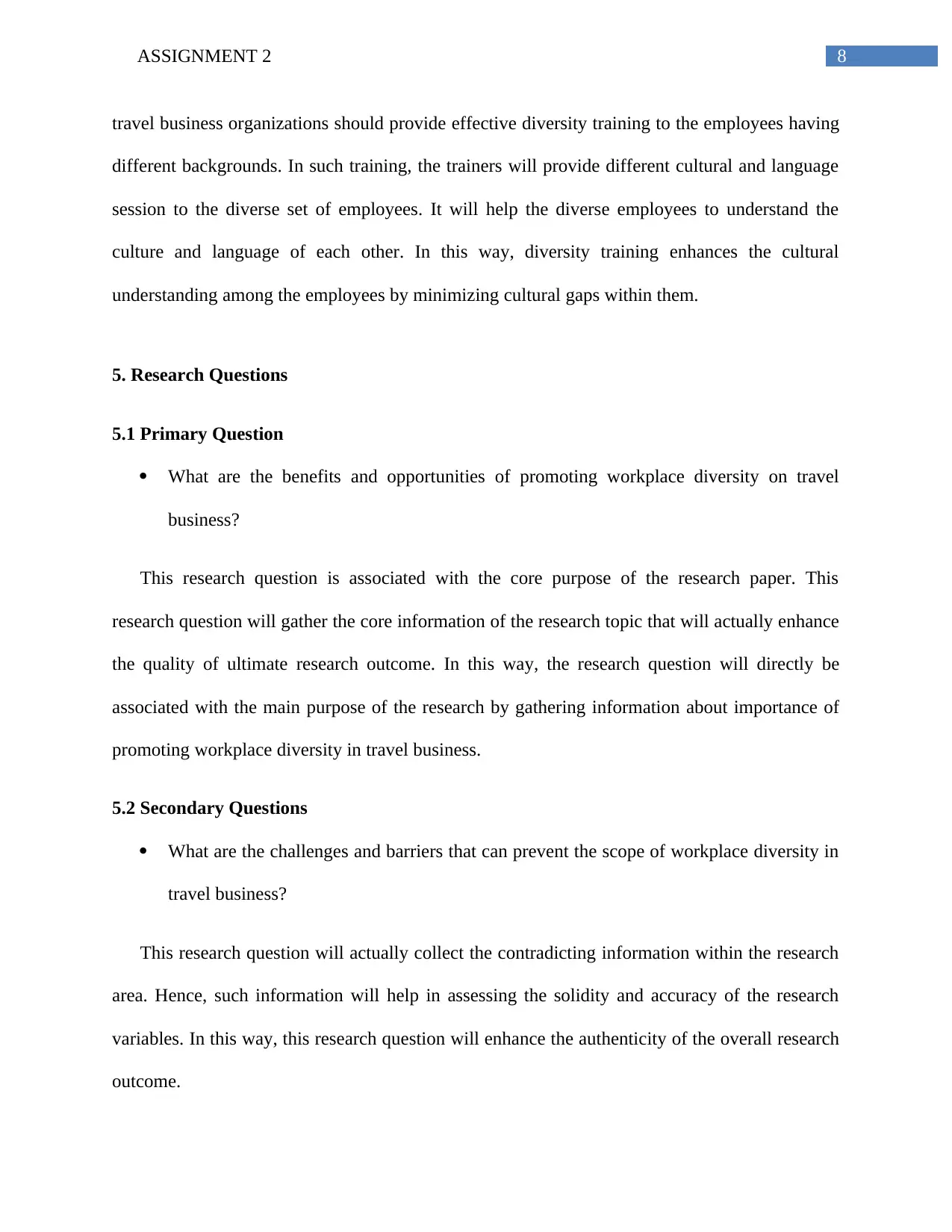
8ASSIGNMENT 2
travel business organizations should provide effective diversity training to the employees having
different backgrounds. In such training, the trainers will provide different cultural and language
session to the diverse set of employees. It will help the diverse employees to understand the
culture and language of each other. In this way, diversity training enhances the cultural
understanding among the employees by minimizing cultural gaps within them.
5. Research Questions
5.1 Primary Question
What are the benefits and opportunities of promoting workplace diversity on travel
business?
This research question is associated with the core purpose of the research paper. This
research question will gather the core information of the research topic that will actually enhance
the quality of ultimate research outcome. In this way, the research question will directly be
associated with the main purpose of the research by gathering information about importance of
promoting workplace diversity in travel business.
5.2 Secondary Questions
What are the challenges and barriers that can prevent the scope of workplace diversity in
travel business?
This research question will actually collect the contradicting information within the research
area. Hence, such information will help in assessing the solidity and accuracy of the research
variables. In this way, this research question will enhance the authenticity of the overall research
outcome.
travel business organizations should provide effective diversity training to the employees having
different backgrounds. In such training, the trainers will provide different cultural and language
session to the diverse set of employees. It will help the diverse employees to understand the
culture and language of each other. In this way, diversity training enhances the cultural
understanding among the employees by minimizing cultural gaps within them.
5. Research Questions
5.1 Primary Question
What are the benefits and opportunities of promoting workplace diversity on travel
business?
This research question is associated with the core purpose of the research paper. This
research question will gather the core information of the research topic that will actually enhance
the quality of ultimate research outcome. In this way, the research question will directly be
associated with the main purpose of the research by gathering information about importance of
promoting workplace diversity in travel business.
5.2 Secondary Questions
What are the challenges and barriers that can prevent the scope of workplace diversity in
travel business?
This research question will actually collect the contradicting information within the research
area. Hence, such information will help in assessing the solidity and accuracy of the research
variables. In this way, this research question will enhance the authenticity of the overall research
outcome.
⊘ This is a preview!⊘
Do you want full access?
Subscribe today to unlock all pages.

Trusted by 1+ million students worldwide
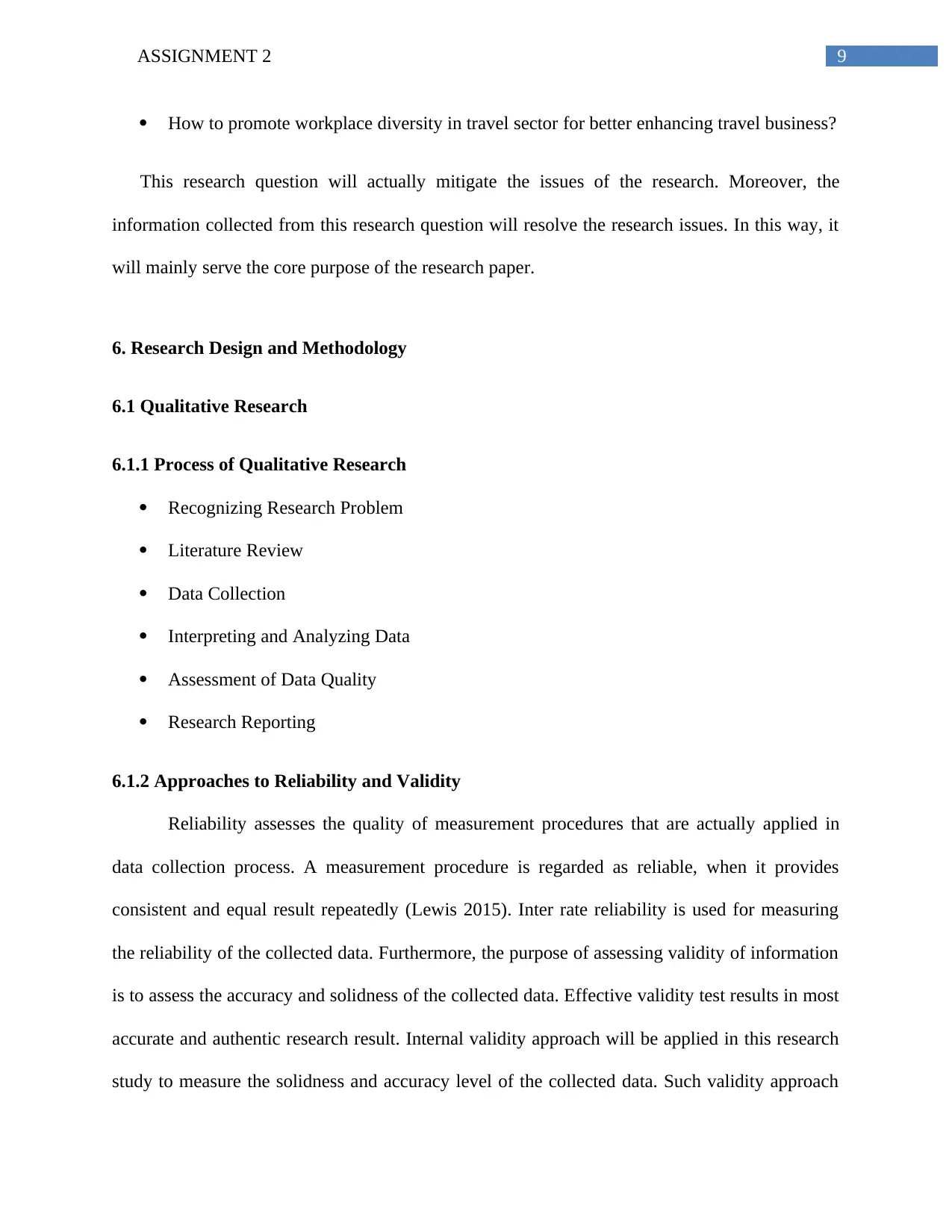
9ASSIGNMENT 2
How to promote workplace diversity in travel sector for better enhancing travel business?
This research question will actually mitigate the issues of the research. Moreover, the
information collected from this research question will resolve the research issues. In this way, it
will mainly serve the core purpose of the research paper.
6. Research Design and Methodology
6.1 Qualitative Research
6.1.1 Process of Qualitative Research
Recognizing Research Problem
Literature Review
Data Collection
Interpreting and Analyzing Data
Assessment of Data Quality
Research Reporting
6.1.2 Approaches to Reliability and Validity
Reliability assesses the quality of measurement procedures that are actually applied in
data collection process. A measurement procedure is regarded as reliable, when it provides
consistent and equal result repeatedly (Lewis 2015). Inter rate reliability is used for measuring
the reliability of the collected data. Furthermore, the purpose of assessing validity of information
is to assess the accuracy and solidness of the collected data. Effective validity test results in most
accurate and authentic research result. Internal validity approach will be applied in this research
study to measure the solidness and accuracy level of the collected data. Such validity approach
How to promote workplace diversity in travel sector for better enhancing travel business?
This research question will actually mitigate the issues of the research. Moreover, the
information collected from this research question will resolve the research issues. In this way, it
will mainly serve the core purpose of the research paper.
6. Research Design and Methodology
6.1 Qualitative Research
6.1.1 Process of Qualitative Research
Recognizing Research Problem
Literature Review
Data Collection
Interpreting and Analyzing Data
Assessment of Data Quality
Research Reporting
6.1.2 Approaches to Reliability and Validity
Reliability assesses the quality of measurement procedures that are actually applied in
data collection process. A measurement procedure is regarded as reliable, when it provides
consistent and equal result repeatedly (Lewis 2015). Inter rate reliability is used for measuring
the reliability of the collected data. Furthermore, the purpose of assessing validity of information
is to assess the accuracy and solidness of the collected data. Effective validity test results in most
accurate and authentic research result. Internal validity approach will be applied in this research
study to measure the solidness and accuracy level of the collected data. Such validity approach
Paraphrase This Document
Need a fresh take? Get an instant paraphrase of this document with our AI Paraphraser
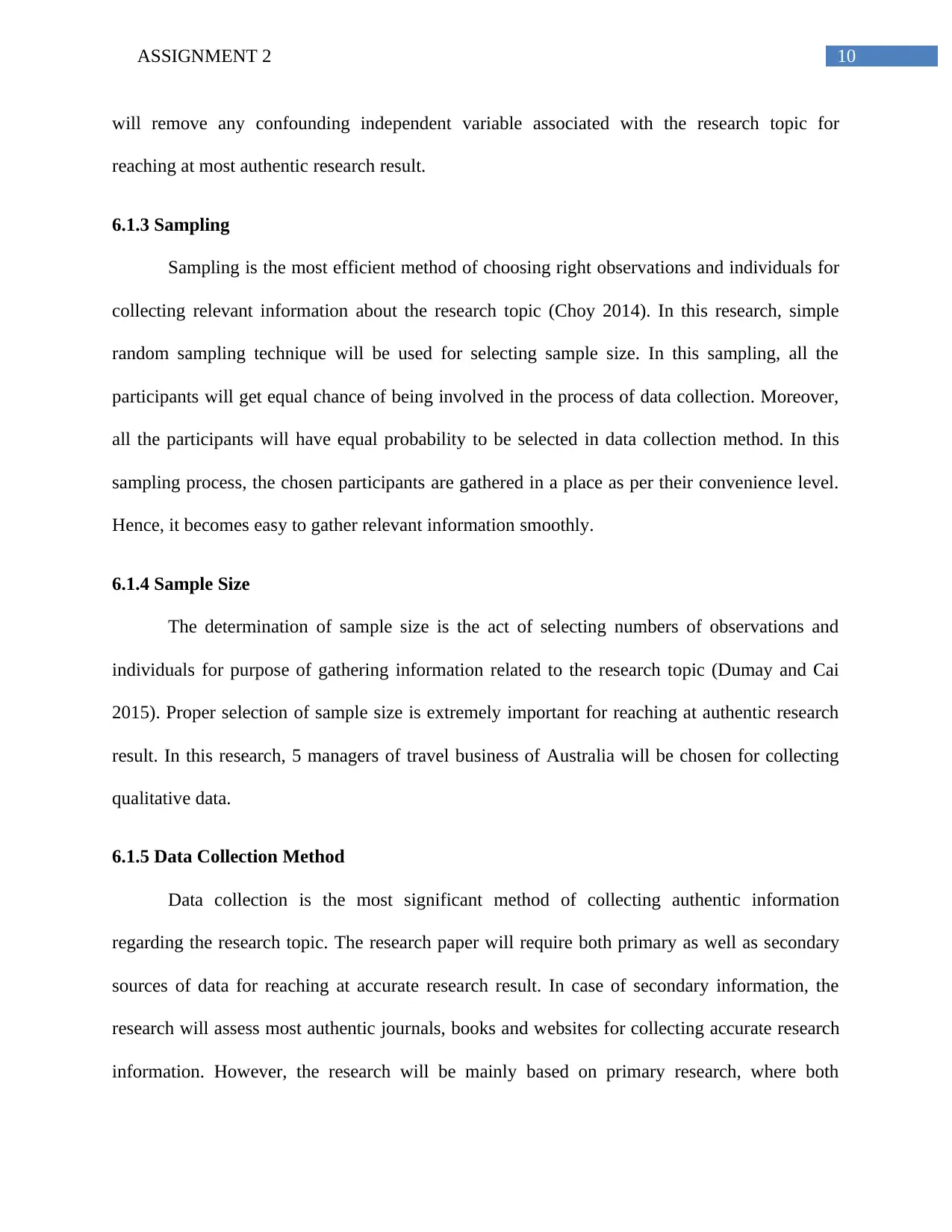
10ASSIGNMENT 2
will remove any confounding independent variable associated with the research topic for
reaching at most authentic research result.
6.1.3 Sampling
Sampling is the most efficient method of choosing right observations and individuals for
collecting relevant information about the research topic (Choy 2014). In this research, simple
random sampling technique will be used for selecting sample size. In this sampling, all the
participants will get equal chance of being involved in the process of data collection. Moreover,
all the participants will have equal probability to be selected in data collection method. In this
sampling process, the chosen participants are gathered in a place as per their convenience level.
Hence, it becomes easy to gather relevant information smoothly.
6.1.4 Sample Size
The determination of sample size is the act of selecting numbers of observations and
individuals for purpose of gathering information related to the research topic (Dumay and Cai
2015). Proper selection of sample size is extremely important for reaching at authentic research
result. In this research, 5 managers of travel business of Australia will be chosen for collecting
qualitative data.
6.1.5 Data Collection Method
Data collection is the most significant method of collecting authentic information
regarding the research topic. The research paper will require both primary as well as secondary
sources of data for reaching at accurate research result. In case of secondary information, the
research will assess most authentic journals, books and websites for collecting accurate research
information. However, the research will be mainly based on primary research, where both
will remove any confounding independent variable associated with the research topic for
reaching at most authentic research result.
6.1.3 Sampling
Sampling is the most efficient method of choosing right observations and individuals for
collecting relevant information about the research topic (Choy 2014). In this research, simple
random sampling technique will be used for selecting sample size. In this sampling, all the
participants will get equal chance of being involved in the process of data collection. Moreover,
all the participants will have equal probability to be selected in data collection method. In this
sampling process, the chosen participants are gathered in a place as per their convenience level.
Hence, it becomes easy to gather relevant information smoothly.
6.1.4 Sample Size
The determination of sample size is the act of selecting numbers of observations and
individuals for purpose of gathering information related to the research topic (Dumay and Cai
2015). Proper selection of sample size is extremely important for reaching at authentic research
result. In this research, 5 managers of travel business of Australia will be chosen for collecting
qualitative data.
6.1.5 Data Collection Method
Data collection is the most significant method of collecting authentic information
regarding the research topic. The research paper will require both primary as well as secondary
sources of data for reaching at accurate research result. In case of secondary information, the
research will assess most authentic journals, books and websites for collecting accurate research
information. However, the research will be mainly based on primary research, where both
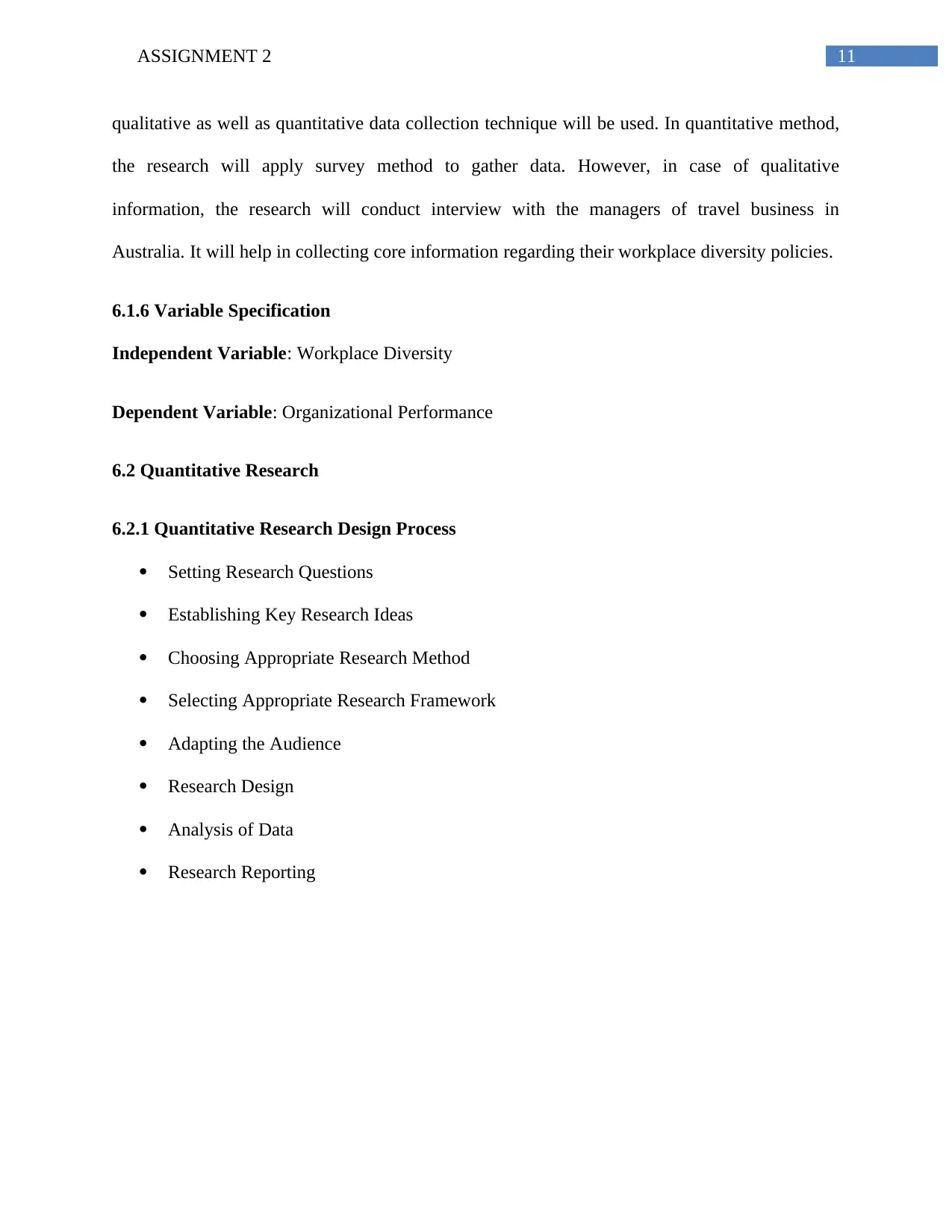
11ASSIGNMENT 2
qualitative as well as quantitative data collection technique will be used. In quantitative method,
the research will apply survey method to gather data. However, in case of qualitative
information, the research will conduct interview with the managers of travel business in
Australia. It will help in collecting core information regarding their workplace diversity policies.
6.1.6 Variable Specification
Independent Variable: Workplace Diversity
Dependent Variable: Organizational Performance
6.2 Quantitative Research
6.2.1 Quantitative Research Design Process
Setting Research Questions
Establishing Key Research Ideas
Choosing Appropriate Research Method
Selecting Appropriate Research Framework
Adapting the Audience
Research Design
Analysis of Data
Research Reporting
qualitative as well as quantitative data collection technique will be used. In quantitative method,
the research will apply survey method to gather data. However, in case of qualitative
information, the research will conduct interview with the managers of travel business in
Australia. It will help in collecting core information regarding their workplace diversity policies.
6.1.6 Variable Specification
Independent Variable: Workplace Diversity
Dependent Variable: Organizational Performance
6.2 Quantitative Research
6.2.1 Quantitative Research Design Process
Setting Research Questions
Establishing Key Research Ideas
Choosing Appropriate Research Method
Selecting Appropriate Research Framework
Adapting the Audience
Research Design
Analysis of Data
Research Reporting
⊘ This is a preview!⊘
Do you want full access?
Subscribe today to unlock all pages.

Trusted by 1+ million students worldwide
1 out of 19